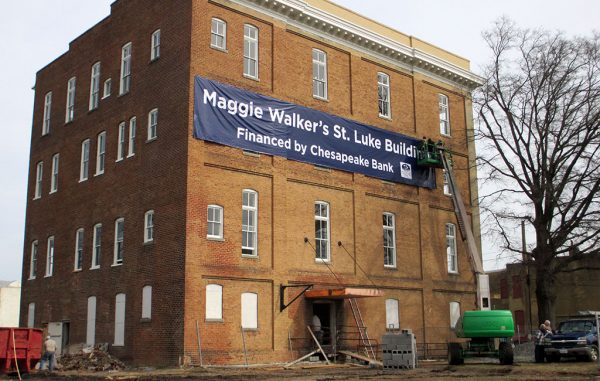The building that served as the epicenter of business for one of Richmond’s most famous entrepreneurs is set to begin a new chapter as an anchor of redevelopment.
The St. Luke Building at 900 St. James St., where businesswoman and activist Maggie Walker became the first woman in the country to open and serve as president of a chartered bank, is being redeveloped as a mixed-use structure housing apartments above a planned ground-floor medical office.
Developer Charles Ayers Jr. of River City Ventures is leading the $3 million project, which started site work six months ago and is applying for a special-use permit to allow the medical office. City Council next week is set to consider that request, which has the support of the planning commission .
Ayers plans to convert the four-story building into a dozen one- and two-bedroom apartments above the 3,700-square-foot commercial space. Ayers said he has a user lined up but would not name the business ahead of next week’s council meeting.
An adjoining two-story wing would house two more apartments, bringing the total residential units to 14.
River City Ventures acquired the property in 2016 from Margaret Stallings, the widow of the late James Russell Stallings, whose Jackson Ward holdings exceeded 100 upon his death in 2000, Ayers said. City property records do not reflect a purchase price for the 0.77-acre parcel, which a city assessment valued at $285,000.
Ayers said Margaret and daughter Wanda Stallings were looking to revive the St. Luke Building and surrounding vacant land when they were referred to him by then-city councilman W.R. “Bill” Johnson. The Stallings family includes Hippodrome redeveloper Ron Stallings, though Ayers said he is not involved in this project.
The building is the first commercial project for Ayers, who said he has built 20 houses primarily in Church Hill. He and his family also own Medical Management Solutions, a medical billing firm they purchased in 2015.
Built around the turn of the 20th century, the St. Luke Building housed the Independent Order of St. Luke, a post-Civil War benevolent group that helped former slaves transition to freedom and provided services such as burial insurance.
Walker, a pioneer in Richmond’s black business community, led the group and based her businesses there, including a weekly newspaper and her St. Luke Penny Savings Bank, which opened in the building in 1903. The bank moved two years later to a space on Broad Street and in 1911 to First and Marshall streets, according to the National Park Service.
Ayers said the building still contained some of Walker’s possessions, including her office chair, a personal safe and the paper’s printing press. He plans to display the chair, safe and other items in the building to commemorate Walker, whose name he’s also adding to the name of the building. A banner sign attached to the property on Wednesday reads: “Maggie Walker’s St. Luke Building.”
River City Ventures is the contractor on the project, which is being designed by Commonwealth Architects. Dunlap & Partners is the mechanical, electrical and plumbing engineer, and The Bay Cos. drew up site plans.
Ayers plans to use historic tax credits on the project, which is being financed by Chesapeake Bank. He expects the building to be finished by yearend.
The apartments will vary between two-bedroom floor plans and one-bedrooms with lofts. Ayers would not say how much the units would rent for, but that they would appeal to workers at VCU’s MCV Campus and Virginia Biotechnology Research Park.
“You’ve got about 8,000 potential tenants there. I only want 14 of them,” he said. “There’s a huge group of people who we feel are candidates for this building, most of them in walking distance.”
Located along the north side of the interstate, the building is adjacent to Gilpin Court, a housing community managed by Richmond Redevelopment & Housing Authority.
Ayers said he is optimistic about the location, noting another development in the area that he expects to have an impact: Community Preservation and Development Corp.’s planned conversion of the nearby Baker School building into senior apartments.
That project is one of two that CPDC is heading up in the area, the other a $32 million mixed-use, mixed-income project called Jackson Place across the interstate.
Where that project would fill a city block of primarily vacant land, Ayers said, the long-term vision for the St. Luke Building is to stimulate development of vacant land around it, likewise owned by the Stallings family.
“We have almost 5 acres that the Stallings family owns that surrounds this property, so we’re going to develop that,” he said, adding that new construction of three-story buildings likely would fill the area.
“The St. Luke Building is the anchor,” Ayers said. “We’ve got to do this first, and then the rest of it will be easy.”
The building that served as the epicenter of business for one of Richmond’s most famous entrepreneurs is set to begin a new chapter as an anchor of redevelopment.
The St. Luke Building at 900 St. James St., where businesswoman and activist Maggie Walker became the first woman in the country to open and serve as president of a chartered bank, is being redeveloped as a mixed-use structure housing apartments above a planned ground-floor medical office.
Developer Charles Ayers Jr. of River City Ventures is leading the $3 million project, which started site work six months ago and is applying for a special-use permit to allow the medical office. City Council next week is set to consider that request, which has the support of the planning commission .
Ayers plans to convert the four-story building into a dozen one- and two-bedroom apartments above the 3,700-square-foot commercial space. Ayers said he has a user lined up but would not name the business ahead of next week’s council meeting.
An adjoining two-story wing would house two more apartments, bringing the total residential units to 14.
River City Ventures acquired the property in 2016 from Margaret Stallings, the widow of the late James Russell Stallings, whose Jackson Ward holdings exceeded 100 upon his death in 2000, Ayers said. City property records do not reflect a purchase price for the 0.77-acre parcel, which a city assessment valued at $285,000.
Ayers said Margaret and daughter Wanda Stallings were looking to revive the St. Luke Building and surrounding vacant land when they were referred to him by then-city councilman W.R. “Bill” Johnson. The Stallings family includes Hippodrome redeveloper Ron Stallings, though Ayers said he is not involved in this project.
The building is the first commercial project for Ayers, who said he has built 20 houses primarily in Church Hill. He and his family also own Medical Management Solutions, a medical billing firm they purchased in 2015.
Built around the turn of the 20th century, the St. Luke Building housed the Independent Order of St. Luke, a post-Civil War benevolent group that helped former slaves transition to freedom and provided services such as burial insurance.
Walker, a pioneer in Richmond’s black business community, led the group and based her businesses there, including a weekly newspaper and her St. Luke Penny Savings Bank, which opened in the building in 1903. The bank moved two years later to a space on Broad Street and in 1911 to First and Marshall streets, according to the National Park Service.
Ayers said the building still contained some of Walker’s possessions, including her office chair, a personal safe and the paper’s printing press. He plans to display the chair, safe and other items in the building to commemorate Walker, whose name he’s also adding to the name of the building. A banner sign attached to the property on Wednesday reads: “Maggie Walker’s St. Luke Building.”
River City Ventures is the contractor on the project, which is being designed by Commonwealth Architects. Dunlap & Partners is the mechanical, electrical and plumbing engineer, and The Bay Cos. drew up site plans.
Ayers plans to use historic tax credits on the project, which is being financed by Chesapeake Bank. He expects the building to be finished by yearend.
The apartments will vary between two-bedroom floor plans and one-bedrooms with lofts. Ayers would not say how much the units would rent for, but that they would appeal to workers at VCU’s MCV Campus and Virginia Biotechnology Research Park.
“You’ve got about 8,000 potential tenants there. I only want 14 of them,” he said. “There’s a huge group of people who we feel are candidates for this building, most of them in walking distance.”
Located along the north side of the interstate, the building is adjacent to Gilpin Court, a housing community managed by Richmond Redevelopment & Housing Authority.
Ayers said he is optimistic about the location, noting another development in the area that he expects to have an impact: Community Preservation and Development Corp.’s planned conversion of the nearby Baker School building into senior apartments.
That project is one of two that CPDC is heading up in the area, the other a $32 million mixed-use, mixed-income project called Jackson Place across the interstate.
Where that project would fill a city block of primarily vacant land, Ayers said, the long-term vision for the St. Luke Building is to stimulate development of vacant land around it, likewise owned by the Stallings family.
“We have almost 5 acres that the Stallings family owns that surrounds this property, so we’re going to develop that,” he said, adding that new construction of three-story buildings likely would fill the area.
“The St. Luke Building is the anchor,” Ayers said. “We’ve got to do this first, and then the rest of it will be easy.”






The area north of I-95/64 is the new one to pioneer for the city’s continuing Renaissance. Watch Brook Road turn!